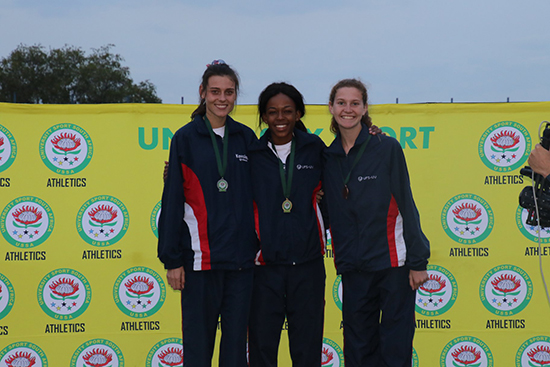Latest News Archive
Please select Category, Year, and then Month to display items
04 May 2018
Photo Facebook
 From left: Marné Mentz (second), Ts’epang Sello (first) and Tyler Beling (third) were in a class of their own, taking the first three spots in the 1 500m at the University Sport South Africa national championship in Sasolburg.
From left: Marné Mentz (second), Ts’epang Sello (first) and Tyler Beling (third) were in a class of their own, taking the first three spots in the 1 500m at the University Sport South Africa national championship in Sasolburg.
As expected, the Kovsie athletics team made the University Sport South Africa (USSA) national championship, held over the weekend in Sasolburg, one to remember.
Eight athletes earned gold medals, which is twice as many as last year. The total of 24 medals (including seven silver and nine bronze) is also double the number won in 2017.
They ended third, just one gold medal below the University of Johannesburg. The female athletes won the women’s competition and contributed to seven of the eight gold medals. The Kovsies dominated the 1 500m and 5 000m events in which they both claimed the first, second and third spots. They even grabbed the fourth and sixth position in the 5 000m in which Kesa Molotsane triumphed, with Tyler Beling second, and Marné Mentz third. Mentz and Beling swapped places in the 1 500m behind Ts’epang Sello.
Molotsane also won the 10 000m in a record time of 34:49.16 which is a massive three minutes and five seconds quicker than the previous record.
The 800m title also now belongs to Sello. She and Beling won a third medal (bronze) as members of the 4 x 400m relay women’s team.
The other gold medalist was Lara Orrock (3 000m steeplechase), Lynique Beneke (long jump), Esli Lamley (pole vault) and Rynardt van Rensburg (800m).
All five Kovsies who competed at the CAA Southern Region Youth & Junior Championships that took place over the weekend in Boksburg, won medals. They were Pakiso Mthembu (gold, 5 000m), Michaéla Wright (gold, long jump), Tyler (gold, 1 500m), Tsebo Matsoso (silver, 200m) and Orrock (silver, 3 000m steeplechase).
Prof Tredoux turns theories regarding the formation of metals on its head
2013-09-17
|
 |
|
Prof Marian Tredoux
17 September 2013 |
The latest research conducted by Prof Marian Tredoux of the Department of Geology, in collaboration with her research assistant Bianca Kennedy and their colleagues in Germany, placed established theories regarding how minerals of the platinum-group of elements are formed, under close scrutiny.
The article on this research of which Prof Tredoux is a co-author – ‘Noble metal nanoclusters and nanoparticles precede mineral formation in magmatic sulphide melts’ – was published in Nature Communications on 6 September 2013. It is an online journal for research of the highest quality in the fields of biological, physical and chemical sciences.
This study found that atoms of platinum and arsenic create nanoclusters, long before the mineral sperrylite can crystallise. Thus, the platinum does not occur as a primary sulphur compound. The research was conducted at the Steinmann Institute of the University of Bonn, Germany, as well as here in Bloemfontein.
Monetary support from Inkaba yeAfrica – a German-South African multidisciplinary and intercultural Earth Science collaborative of the National Research Foundation (NRF) – made this research possible. Studies are now also being conducted on other metals in the precious metal group, specifically palladium, rhodium and ruthenium.
The discovery of the nanoclusters and the combination with arsenic can have far-reaching consequences for the platinum mine industry, if it can be utilised to recover a greater amount of platinum ore and therefore less wastage ending up in mine dumps. This will signify optimal mining of a scarce and valuable metal, one of South Africa’s most important export products.
For Prof Tredoux, the research results also prove thoughts she already had some twenty years ago around the forming of platinum minerals. “Researchers laughed in my face, but the evidence had to wait for the development of technology to prove it.” Young researchers were very excited at recent congresses about the findings, since the new models can bring new insights.
“Chemistry researchers have been talking about platinum element clusters in watery environments for quite a while, but it was thought that these would not appear in magmas (molten rock) due to the high temperatures (>1 000 degrees celsius).”
Prof Tredoux has already delivered lectures at congresses in Scotland, Hungary, Sweden and Italy on this research.
Read the article at: http://www.nature.com/ncomms/2013/130906/ncomms3405/full/ncomms3405.html